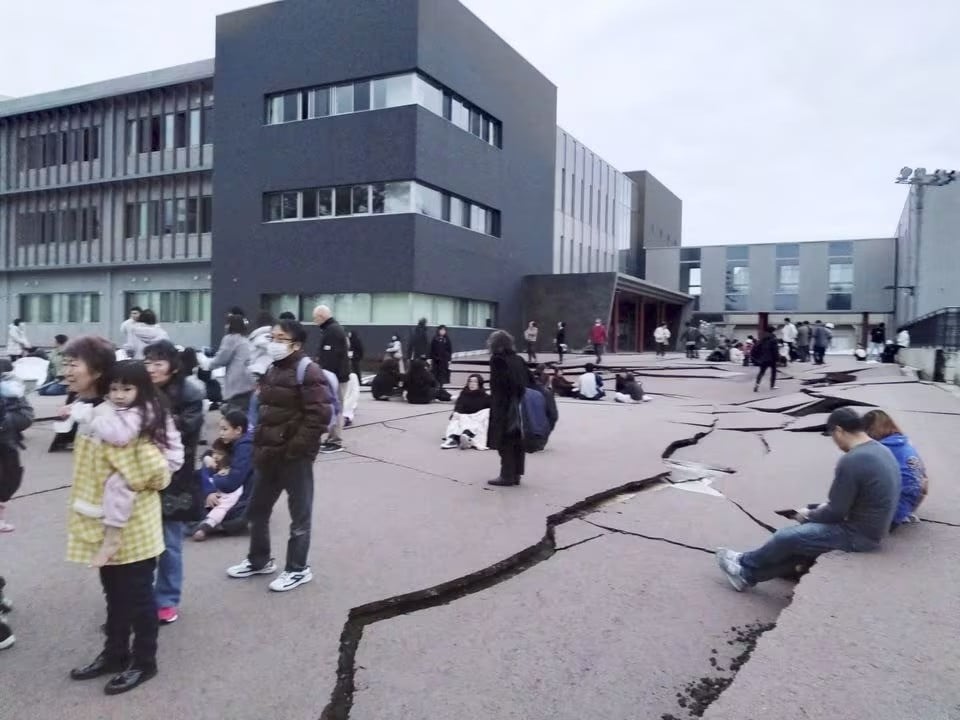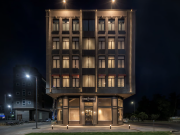TOKYO: On Monday, a massive earthquake hit central Japan, causing buildings to collapse, thousands of houses to lose power, and traffic to the area to be disrupted. Residents were warned to evacuate several locations on the west coast.

Authorities have warned that greater waves may follow the earthquake, which has a preliminary magnitude of 7.6 and caused waves of about 1 metre along portions of the coast of the Sea of Japan.
Warnings of a tsunami were issued for the coastal prefectures of Ishikawa, Niigata, and Toyama by the Japan Meteorological Agency (JMA). Originally issued for Ishikawa, a significant tsunami warning was subsequently downgraded; this was the first such warning since the earthquake and tsunami that hit northeastern Japan in March 2011.
Vladivostok and Nakhodka, two cities in Russia’s far east, were also warned of a tsunami.
Yoshimasa Hayashi, a senior government spokeswoman, informed reporters that authorities are still analysing the damage, but that several houses have been damaged and that army soldiers have been sent to assist with rescue operations.
Toshihiro Shimoyama, an official from the JMA, warned that the region has been experiencing seismic activity for over three years and that more powerful earthquakes may hit in the next days.
Not long after the earthquake hit, Prime Minister Fumio Kishida spoke to the media, advising citizens to be ready for future natural catastrophes.
“Residents need to stay on alert for further possible quakes and I urge people in areas where tsunamis are expected to evacuate as soon as possible,” stated Kishida.
Television screens flashed a big yellow warning that said “Run!” and urged people in certain coastal locations to leave their homes immediately.
Photographs captured by local media showed a building in the seaside city of Suzu tumbling down in a cloud of dust, while in Wajima, a massive fissure in the road caused parents to hold their children in apparent fear. According to NHK’s reporting quoting the Wajima fire department, at least 30 structures in the city had collapsed.
Buildings in Tokyo, the capital city 500 km away on the other coast from Wajima, were also rocked by the earthquake.
Utilities supplier Hokuriku Electric Power (9505.T) said that over 36,000 homes in the prefectures of Ishikawa and Toyama had experienced power outages.
There has been a suspension of high-speed rail services to Ishikawa, while telecom carriers KDDI (9433.T) and Softbank (9434.T) have both reported disruptions to phone and internet service in Niigata and Ishikawa, respectively, on their websites.
Japanese officials have announced the closure of one airport in Ishikawa, and Japanese carrier ANA (9202.T) has turned backplanes destined for Toyama and Ishikawa airports. Japan Airlines (9201.T) has also cancelled most of its services to the Niigata and Ishikawa regions.
Power plants that use nuclear energy
Nuclear power stations around the Sea of Japan, including five active reactors at Kansai Electric Power’s (9503.T) Ohi and Takahama plants in Fukui Prefecture, have not been found to have any anomalies, according to Japan’s Nuclear Regulation Authority.
The Shika facility in Ishikawa, which is the nuclear power station closest to the earthquake’s epicentre, had already shut down its two reactors for routine inspections before to the tremor and did not experience any damage as a result of the quake, according to the agency.
Fukushima nuclear meltdowns began in 2011 after an earthquake and tsunami that killed around 20,000 people, levelled towns, and caused widespread devastation.
More than 6,000 people, mostly in Kobe, were killed in the 1995 Great Hanshin Earthquake, which struck western Japan.
The earthquake that happened on Monday happened on January 1, the day that millions of Japanese people go to temples to celebrate the new year.
Pictures taken in Kanazawa, a famous tourist spot in Ishikawa, showed worshippers standing anxiously at the entrance of a temple with the pieces of a fallen gate scattered around.
Plus: a 7.5-magnitude earthquake hits the Philippines, and Japan and the Philippines are bracing for tsunamis.
Ayako Daikai, a resident of Kanazawa, stated that she and her husband and two children had escaped to an adjacent elementary school immediately following the earthquake. Evacuees were crammed into every available space, including classrooms, hallways, stairwells, and the gym, according to her.
“I also experienced the Great Hanshin Earthquake, so I thought it would be safest to evacuate,” she told Reuters when called by telephone on the phone.
“We haven’t decided when to return home yet.”
Even visitors to the Nagano region in Japan, a popular destination for winter sports enthusiasts, felt the shock.
As the 50-year-old snowboarder Johnny Wu of Taiwan waited for a shuttle bus to return him to his hotel in the resort town of Hakuba, the earthquake shook the snow from roofs and power lines above him, shattering windows.
There was widespread fear at that moment. Being from Taiwan has given me a lot of life experience, which has made me a little bit better. “However, I remain concerned that the earthquake could become even more devastating,” he stated.
Pictures from the adjacent town of Wajima showed homes that had collapsed and a massive fissure running down a concrete road, where parents appeared to be cradling their children in a state of terror.










































